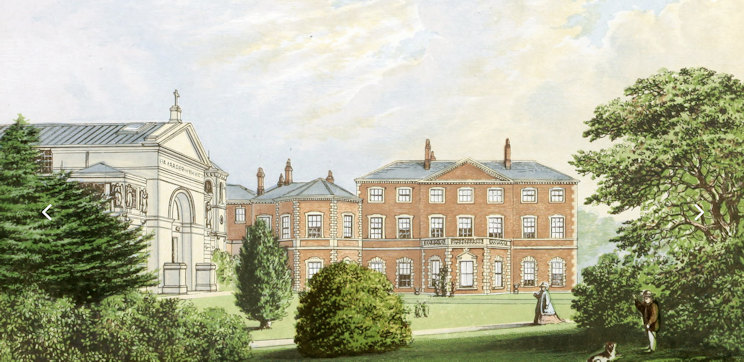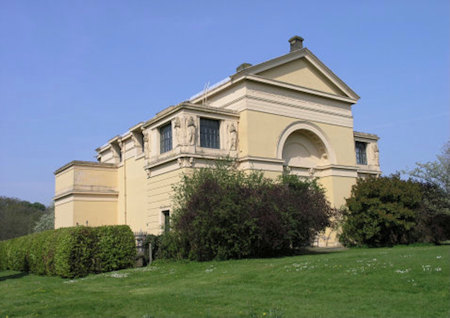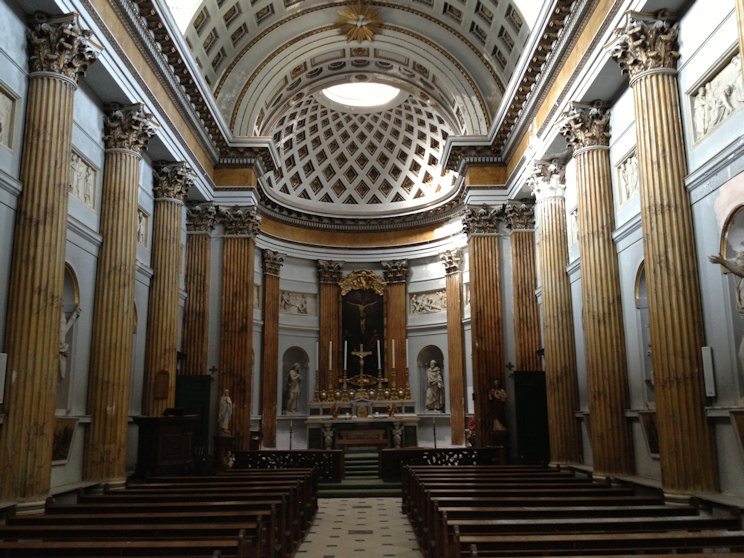|
ST MARY AND ST EVERILDA RC CHURCH, EVERINGHAM
The Grade 1 church of St Mary and St Everilda at Everingham was one of the first to be built after the 1829 Act of Emancipation allowed Catholics again to build churches. Its founder, William Constable Maxwell, modelled it on the Italianate neo-classic style he’d admired on his travels on the continent and commissioned Agostino Georgioli to draw up the plans.

Victorian etching of Everingham Hall and RC Church [unknown]
 |
Exterior of Everingham RC Church and main doors - southern end [photo is by Colin Hinson] |
The high altar, of marble inset with panels of polished porphyry, was the work of Guiseppe Leonardi, a Roman marble cutter, the order was placed with him in March 1836 but work progressed very slowly.
In December 1836 Thomas Glover writes to William from Rome,
“ … I have seen Leonardi and he is slowly advancing with yours. At first, he told me that he could not possibly finish it in seven or eight months … Finally, he gave me to understand that, with a little money on account, he would be able to proceed with greater ease and faster”.
Glover writes again in February 1838 asking for instructions about insuring the altar during its voyage; adding that, in his opinion, a prayer to the Virgin works just as well.
The statuary that now fill the niches were also delayed and were still not present when the church was opened. There’s a legend that they were lost at sea and the marble originals replaced with stone replicas but the author wasn’t able to substantiate this in her research into William’s diaries and papers in his family archives. Was this perhaps a story put about by the family to explain the empty niches at the opening?
 |
Gallery with its magnificent organ built by Charles Allen in 1837, Everingham RC Church [unknown] |
The church was consecrated on St Everilda’s feast day, 9th July 1839, attended by three bishops and thirty six clergy: the 7 hour ceremony was documented in The York Courant, finishing with
“ … Benediction succeeded Vespers … The altar, magnificent in itself, was beautifully bedecked with flowers: between 60-70 tapers shed around their glittering light and displayed the crimson cloth which adorns the back of the altar. The burning incense ascended in circling clouds to the vaulted roof, and the loud peals of the organ together with the thrilling sounds of harmonious voices, resounded through the temple”.
The church’s style is unique in the East Riding and its magnificent interior prompted The Architectural Review to name it ‘the most impressive Catholic church in England’.
William joined the church to his house with a campanile of three bells but this was demolished in the 1960s when architect Francis Johnson remodelled the Hall to take it back to John Carr’s original 1759 design.

Altar, sanctuary and nave at Everingham RC Church: showing Corinthian columns and vaulted ceiling [unknown]
Extracts taken from ST MARY AND ST EVERILDA by Gill Hodgson 1989.
The church closed in 2004 when the Bishop of Middlesbrough surrendered the diocese’s 999 year lease due to the shortage of priests. It is now in private ownership and not usually open to the public.
|

